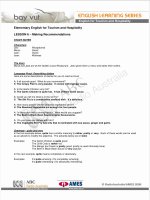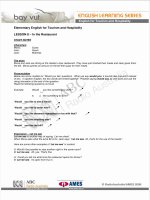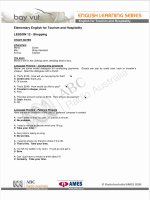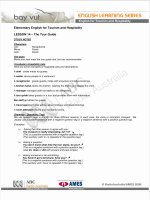Optimal designs for linear and nonlinear precoders and decoders
Bạn đang xem bản rút gọn của tài liệu. Xem và tải ngay bản đầy đủ của tài liệu tại đây (679.46 KB, 145 trang )
OPTIMAL DESIGNS FOR LINEAR AND
NONLINEAR PRECODERS AND DECODERS
LI NAN
NATIONAL UNIVERSITY OF SINGAPORE
2006
OPTIMAL DESIGNS FOR LINEAR AND
NONLINEAR PRECODERS AND DECODERS
LI NAN
(B.Eng., Dalian University of Technology, China)
A THESIS SUBMITTED
FOR THE DEGREE OF MASTER OF ENGINEERING
DEPARTMENT OF ELECTRICAL AND COMPUTER ENGINEERING
NATIONAL UNIVERSITY OF SINGAPORE
2006
Acknowledgment
I must thank my family for all their support, love and care, without
which I can never survive.
I would like to express my warmest thanks to those who have consistently been helping me with my research work.
I am grateful to my supervisors, Dr. Abdul Rahim Bin Leyman and
Dr. Cheok Adrian David, for their encouragement, support and valuable
advice on my research work, all along the way of improving both my skills in
research and my attitude to overcome problems. I also would like to express
my gratitude to those professors and lecturers who have taught me for their
constructive suggestions to my study.
Last but not least, I want to thank sincerely all my colleagues and
friends in I2 R for having provided such a great environment to work in.
i
Contents
Acknowledgment
i
Contents
ii
List of Figures
v
List of Tables
viii
Abbreviations
ix
Summary
xi
Chapter 1. Introduction
1
1.1
Trends on Wireless Communications . . . . . . . . . . . . . .
1
1.2
Channel Coding, Equalization and Precoding Techniques . . .
6
1.2.1
Channel Coding . . . . . . . . . . . . . . . . . . . . . .
6
1.2.2
Channel Equalization . . . . . . . . . . . . . . . . . . . 12
1.2.3
Channel Precoding . . . . . . . . . . . . . . . . . . . . 14
1.3
Motivation and Contribution of The Thesis . . . . . . . . . . . 20
1.4
Organization of The Thesis
. . . . . . . . . . . . . . . . . . . 22
Chapter 2. Background Preliminaries
2.1
24
Cyclic Prefixed and Zero Padding Transmission Method . . . . 25
2.1.1
Cyclic Prefixed . . . . . . . . . . . . . . . . . . . . . . 25
2.1.2
Zero Padding . . . . . . . . . . . . . . . . . . . . . . . 28
2.1.3
Comparisons Between CP and ZP . . . . . . . . . . . . 31
ii
Contents
iii
2.2
Optimal Designs for Precoders and Decoders . . . . . . . . . . 33
2.3
Summary . . . . . . . . . . . . . . . . . . . . . . . . . . . . . 45
Chapter 3. Linear Precoder and Decoder Design
46
3.1
Introduction . . . . . . . . . . . . . . . . . . . . . . . . . . . . 46
3.2
System Model . . . . . . . . . . . . . . . . . . . . . . . . . . . 48
3.3
Weighted Information Rate Design . . . . . . . . . . . . . . . 54
3.4
3.3.1
Minimum Mean-Squared Error (MMSE) Design . . . . 62
3.3.2
Maximum Information Rate (MIR) Design . . . . . . . 63
3.3.3
QoS Based Design . . . . . . . . . . . . . . . . . . . . 65
Summary . . . . . . . . . . . . . . . . . . . . . . . . . . . . . 68
Chapter 4. Nonlinear DFE-based Precoder/Decoder
69
4.1
Introduction . . . . . . . . . . . . . . . . . . . . . . . . . . . . 69
4.2
System Model . . . . . . . . . . . . . . . . . . . . . . . . . . . 72
4.3
Optimal Design for Non-linear DFE-based Precoders and Decoders . . . . . . . . . . . . . . . . . . . . . . . . . . . . . . . 77
4.4
4.3.1
Maximum Information Rate Precoder . . . . . . . . . . 77
4.3.2
Minimum Bit Error Rate Decoder . . . . . . . . . . . . 80
Summary . . . . . . . . . . . . . . . . . . . . . . . . . . . . . 84
Chapter 5. Simulation Results and Discussions
86
5.1
Introduction . . . . . . . . . . . . . . . . . . . . . . . . . . . . 86
5.2
Performances of Linear Schemes . . . . . . . . . . . . . . . . . 88
5.3
5.4
5.2.1
Information Rate Performance . . . . . . . . . . . . . . 88
5.2.2
Mean-Squared Error Performance . . . . . . . . . . . . 96
5.2.3
Subchannel SNR Performance . . . . . . . . . . . . . . 100
Performances of Nonlinear Schemes . . . . . . . . . . . . . . . 101
5.3.1
Information Rate Performance . . . . . . . . . . . . . . 104
5.3.2
Bit Error Rate Performance . . . . . . . . . . . . . . . 105
Summary . . . . . . . . . . . . . . . . . . . . . . . . . . . . . 111
Chapter 6. Conclusions and Future Work
113
Contents
iv
6.1
Conclusions . . . . . . . . . . . . . . . . . . . . . . . . . . . . 113
6.2
Future Work . . . . . . . . . . . . . . . . . . . . . . . . . . . . 116
Bibliography
118
Appendix A. Proof of Jensen’s Inequality
124
Appendix B. Proof of Lemma 1 in [30]
126
Appendix C. Proof of Eqn.(3.37)
128
Appendix D. Proof of Eqn.(4.14)
130
List of Figures
1.1
Basic Elements of a Digital Communication System . . . . . .
4
1.2
Classification of Channel Coding Techniques . . . . . . . . . .
7
1.3
Block Coding . . . . . . . . . . . . . . . . . . . . . . . . . . .
8
1.4
Soft Decision . . . . . . . . . . . . . . . . . . . . . . . . . . .
9
1.5
Hard Decision . . . . . . . . . . . . . . . . . . . . . . . . . . .
9
1.6
Trellis Encoder . . . . . . . . . . . . . . . . . . . . . . . . . . 10
1.7
Classification of Equalizers . . . . . . . . . . . . . . . . . . . . 13
1.8
Decision Feedback Equalizer (DFE) . . . . . . . . . . . . . . . 15
2.1
Block Transmission System Model . . . . . . . . . . . . . . . . 25
2.2
Block Transmission with Zero Padding Method . . . . . . . . 30
3.1
Linear Block Transmissions Communication System . . . . . . 49
3.2
Linear Block Transmissions Communication System without
IBI . . . . . . . . . . . . . . . . . . . . . . . . . . . . . . . . . 52
3.3
Equivalent Subchannels . . . . . . . . . . . . . . . . . . . . . . 54
4.1
Nonlinear Block Transmissions Communication System . . . . 72
4.2
Nonlinear Block Transmissions Communication System without IBI . . . . . . . . . . . . . . . . . . . . . . . . . . . . . . . 75
4.3
Block Transmissions Communication System Concatenated with
DFT Matrix . . . . . . . . . . . . . . . . . . . . . . . . . . . . 85
v
List of Figures
5.1
vi
Information Rate Performance of MIR Design and MMSE Design With M = 5 . . . . . . . . . . . . . . . . . . . . . . . . . 90
5.2
Information Rate Performance of MIR Design and MMSE Design With M = 7 . . . . . . . . . . . . . . . . . . . . . . . . . 90
5.3
Information Rate Performance of MIR Design and MMSE Design With M = 10 . . . . . . . . . . . . . . . . . . . . . . . . 91
5.4
Frequency Response of Channel a1 . . . . . . . . . . . . . . . 92
5.5
Frequency Response of Channel a2 . . . . . . . . . . . . . . . 92
5.6
Information Rate Performance of MIR Design and MMSE Design Using Channel a1 . . . . . . . . . . . . . . . . . . . . . . 95
5.7
Information Rate Performance of MIR Design and MMSE Design Using Channel a2 . . . . . . . . . . . . . . . . . . . . . . 95
5.8
Mean-Squared Error Performance of MIR Design and MMSE
Design for Channel a1 . . . . . . . . . . . . . . . . . . . . . . 97
5.9
Mean-Squared Error Performance of MIR Design and MMSE
Design for Randomly Generated Channel With M = 7 . . . . 97
5.10 Mean-Squared Error Performance of MIR Design and MMSE
Design for Randomly Generated Channel With M = 5 . . . . 99
5.11 Mean-Squared Error Performance of MIR Design and MMSE
Design for Randomly Generated Channel With M = 10 . . . . 99
5.12 Subchannel SNR Performance of QoS Based Design(in dB) . . 102
5.13 Subchannel SNR Performance of QoS Based Design . . . . . . 102
5.14 Subchannel SNR Performance of MMSE Design . . . . . . . . 103
5.15 Information Rate Performance of MBER-DFE and ZF-DFE
and MMSE-DFE Designs Using Channel a1
. . . . . . . . . . 105
5.16 Information Rate Performance of MBER-DFE and ZF-DFE
and MMSE-DFE Designs Using Channel a2
. . . . . . . . . . 106
List of Figures
vii
5.17 Bit Error Rate Performance of MBER-DFE and MMSE-DFE
Designs for Channel a1 . . . . . . . . . . . . . . . . . . . . . . 107
5.18 Bit Error Rate Performance of MBER-DFE and MMSE-DFE
Designs for Channel a2 . . . . . . . . . . . . . . . . . . . . . . 109
5.19 Frequency Response of Channel a3 . . . . . . . . . . . . . . . 109
5.20 Bit Error Rate Performance of MBER-DFE and MMSE-DFE
Designs for Channel a3 . . . . . . . . . . . . . . . . . . . . . . 110
5.21 Bit Error Rate Performance of MBER-DFE and MMSE-DFE
Designs for Randomly Generated Channel . . . . . . . . . . . 111
List of Tables
5.1
Comparison of Information Rate between MIR Design and
MMSE Design Using Random Generated Channels . . . . . . 88
5.2
Comparison of Information Rate between MIR Design and
MMSE Design Using Channels a1 and a2 . . . . . . . . . . . . 93
5.3
Comparison of Mean-Squared Error between MMSE Design
and MIR Design Using Randomly Generated Channels . . . . 98
6.1
Linear Precoders and Decoders . . . . . . . . . . . . . . . . . 114
viii
Abbreviations
ADSL
Asymmetric Digital Subscriber Line
BPSK
Binary Phase Shift Keying
CDMA
Code Division Multiple Access
CP
Cyclic Prefixed
CSI
Channel State Information
DFE
Decision-Feedback Equalizer
DFT
Discrete Fourier Transform
DMT
Discrete Multitone Modulation
FBF
Feedback Filter
FDD
Frequency Division Duplexing
FFF
Feed-Forward Filter
FIR
Finite Impulse Response
GMSE
Geometric Mean-Squared Error
GPRS
General Packet Radio Service
GSM
Global System Mobile
HDSL
High-bit-rate Digital Subscriber Line
IBI
Interblock Interference
ISP
Internet Service Provider
ix
Abbreviations
ISI
Intersymbol Interference
LTE
Linear Transversal Equalizer
MBER
Minimum Bit Error Rate
MIMO
Multiple Input Multiple Output
MIR
Maximum Information Rate
MMSE
Minimum Mean-Squared Error
NADC
North American Digital Cellular
OFDM
Orthogonal Frequency Division Multiplexing
PDC
Pacific Digital Cellular
QPSK
Quadrature Phase Shift Keying
SISO
Single-Input Single-Output
SNR
Signal-to-Noise Ratio
SVD
Singular Value Decomposition
TDD
Time Division Duplexing
TDMA
Time Division Multiple Access
ZF
Zero-Forcing
ZP
Zero Padding
x
Summary
Channel precoding and decoding is a new paradigm that is introduced
during recent years. It is used to shape the transmitted signal and to introduce the redundancy in order to eliminate the intersymbol interference.
In this thesis, we present several linear and nonlinear optimal designs for
precoders and decoders.
A lot of research work has been done for designing better performance
precoder/decoder pair. Such as minimizing the mean-squared error, maximizing the information rate, minimizing the bit error rate and so on. In
this thesis, we introduce a new criterion named weighted information rate
criterion for our linear design. This criterion is a generalization of the optimal linear precoder and decoder design. By choosing corresponding weight
matrix, we can obtain maximum information rate (MIR) design, minimum
mean-squared error (MMSE) design and QoS based design.
For the DFE-based nonlinear precoder and decoder design, we firstly
design a precoder which can maximize the information rate, then on the
basis of this design, we further improve it by trying to minimize the bit
xi
SUMMARY
xii
error rate (MBER) and maximize the information rate together. We are
using Lagrangian optimizing method to make the eigenvectors of the precoder
matrix match to the eigenvectors of the circulant channel matrix in order to
maximize the information rate. And we use discrete fourier transform (DFT)
matrix to ensure that the average bit error rate is a convex function and has
the minimum value, so by adopting MMSE criterion we can achieve that
minimum value. Therefore, the optimal design is obtained.
Various simulation results prove the improvements of our linear and
nonlinear optimal precoders and decoders designs. For linear weighted information rate criterion, the results show that we can achieve different kind of
designs by choosing the weight matrix properly. The MIR design maximizes
the information rate. The MMSE design obtains optimum performance of
MSE and the QoS based design allows us to transmit different signals under
different subchannel SNR requirements. For DFE-based nonlinear designs,
the improvement of the information rate of our MMER-DFE design over the
MMSE-DFE design is considerable. Also, our MBER-DFE design always
has better BER performance, regardless of the channel frequency selectivity.
And the more frequency selective the channel performed, the more obvious
the SNR gain we observed of MBER-DFE design.
Chapter 1
Introduction
1.1
Trends on Wireless Communications
Wireless communications is now undergoing its fastest growth period in
history. The emergence of wireless cellular communication systems brings
about an exciting revolution to the wireless industry in terms of both technologies and applications. The number of worldwide cellular telephone subscribers has exceeded 600 million in late 2001 [1] and the total number of
worldwide subscribers to wireless cellular services will exceed 2 billion by
2007, according to a new report from In-Stat/MDR. Most of today’s ubiquitous cellular networks use the second generation (2G) technologies which
comform to the second generation cellular standards. Unlike the first generation cellular systems that adopted Frequency Division Multiple Access
(FDMA), Frequency Division Duplexing (FDD) and analog FM, 2G stan1
CHAPTER 1. INTRODUCTION
2
dards rely on digital modulation formats and Time Division Multiple Access
(TDMA)/FDD and Code Division Multiple Access (CDMA)/FDD multiple
access techniques.
Global System Mobile (GSM), North American Digital Cellular (NADC),
Pacific Digital Cellular (PDC) and Interim Standard 95 Code Division Multiple Access (IS-95) are four of the 2G standards which are used popularly.
GSM supports eight time slotted users for each 200 kHz radio channel.
NADC supports three time slotted users for each 30 kHz radio channel while
PDC is similar to NADC. IS-95 supports up to 64 users that are orthogonally
coded and simultaneously transmitted on each 1.25 MHz channel and is also
known as cdmaOne [1].
In order to improve the 2G standards for compatibility with increased
throughput data rates on demand, new standards have been developed that
can be overlaid upon existing 2G technologies. These new standards are
known as the 2.5G technologies. 2.5G systems, such as GPRS, which is
a radio technology for GSM networks, boasts of many new features. For
instance, it adds packet-switching protocols and requires shorter set-up time
for ISP connections, and can even provide up to about 100 Kbps data rate.
Many commercial GPRS systems were deployed worldwide at the end of
1990s. Also, IS-95B is an upgrade of IS-95, which can provide high-speed
packet and circuit switched data access on a common CDMA radio channel.
At the end of 1990s, the third generation (3G) cellular communication
systems were finalized to provide better data service. 3G system allows
unparalleled wireless access in ways that have never been possible before.
CHAPTER 1. INTRODUCTION
3
There are two major 3G technology standards: CDMA2000 and Wideband
CDMA (W-CDMA). CDMA2000 are based on the fundamentals of IS-95
and IS-95B technologies and has several variants. W-CDMA is based on the
fundamentals of GSM and assures backward compatibility with the second
generation GSM. The network structure and bit level packaging of GSM data
is retained by W-CDMA, with additional capacity and bandwidth provided
by a new CDMA air interface.
Although 3G technologies have improved significantly over the years,
it is still inferior in many years, compared to the fixed wire line Internet
connection. Most Local Area Networks (LAN) in campus/office support 100
Mbps data rate at very low costs. For high data rate transmission, conventional cellular communication systems are uneconomical since they have
to pay attention to covering wide areas, supporting highly mobile users and
providing seamless handover. Wireless LAN was hence proposed to address
this problem. Compared to cellular communication systems, a wireless LAN
cell covers up to several hundreds meters [1], the range of a hot spot, and
supports 10 Mbps to 50 Mbps data rate for each user. Currently, the most
popular wireless LAN standard is 802.11b, which can support up to 10 Mbps
data rate and has been installed at some hot spots, such as airports, hotels,
and campus.
At the same time, other wireless technologies are also under intensive
study and some are rapidly becoming pervasive in our everyday life. For
instance, Bluetooth, Wireless Personal Area Networks (802.15) and Fixed
Broadband Wireless Access Standards (802.16).
CHAPTER 1. INTRODUCTION
Input
Signal
Source
Encoder
Channel
Encoder
4
Digital
Modulator
Channel
Output
Signal
Source
Decoder
Channel
Decoder
Digital
Demodulator
Figure 1.1: Basic Elements of a Digital Communication System
High data transmission rates, low bit error rates over different kinds
of wireless channels within the limited radio spectrum are just some of the
pre-requisites of the wireless industry today. The need to achieve these requirements, has driven researchers to look for better communication and
signal processing technologies. Some techniques, such as modulation, equalization, diversity and coding have been extensively studied during the past
decades.
Figure 1.1 shows the basic elements of a digital communication system.
Modulation is the process of encoding information from a message source
in a manner suitable for transmission. It is generally concerned of translating the baseband message signal to a bandpass signal whose frequencies are
very high when compared to the baseband frequency. The baseband message signal is called the modulating signal and the bandpass signal is called
the modulated signal. Modulation techniques can be further divided into
frequency modulation, amplitude modulation and phase modulation. Frequency modulation is the most popular analog modulation technique used
in mobile radio systems. It has better noise immunity and works more ef-
CHAPTER 1. INTRODUCTION
5
ficiently when compared to amplitude modulation. But it requires a wider
frequency band and the equipments used for transmitting and receiving are
more complex.
Diversity is another communication technique which is used to compensate for fading channel impairments. It improves the quality of a wireless
communications link without increasing the transmitted power or bandwidth.
Diversity techniques are often employed at both base station and mobile receivers. The most common diversity technique is spatial diversity. Other
diversity techniques include frequency diversity and time diversity.
More recently, linear and nonlinear precoding and decoding techniques
have become popular research areas because of their simple closed-form solutions for transmission over frequency-selective multiple-input multiple-output
channels. We use precoders and decoders to minimize the bit error rate and
eliminate the inter-symbol interferences and they can protect digital data
from errors by selectively introducing redundancies in the transmitted data.
In the next section, I will first introduce the fundamentals of channel
coding and equalization techniques, followed by a discussion of the research
on channel precoding technique. Finally, I will put forth the optimal designs
of linear and nonlinear precoders and decoders, and issues on the criterions
used in the designs.
CHAPTER 1. INTRODUCTION
1.2
6
Channel Coding, Equalization and Precoding Techniques
1.2.1
Channel Coding
The channel encoder is a discrete-input, discrete-output device whose
usual purpose is seen as providing some error-correction capability for the
system [2]. It does this by using a mapping from input sequences to code
sequences, which inserts redundancy and utilizes memory. This means that
the process of channel coding produces modulator input symbols that are
interrelated, introducing a crucial aspect of memory into the signaling process. At the same time, a controlled redundancy is introduced. It is well
known [2] that redundancy introduced in the transmitter of a communication system may allow us to overcome serious intersymbol interference (ISI)
problems due to highly dispersive channels. The channel decoder exploits
the redundancy to decide which message bit was actually transmitted. The
reasons for adopting coding are, widely speaking, to achieve highly reliable
communication at rates approaching the channel capacity limit defined by
the physical channel. Channel coding is useful in virtually every kind of
noisy channel transmission problem; some still regard its principal area of
application as the unlimited-bandwidth channel, but recently major contributions to practical communications have been made by intelligent coding
for band-limited channels. Coding also offers particularly impressive gains on
fading and time-varying interference channels. Channel codes that are used
CHAPTER 1. INTRODUCTION
7
Channel
Codes
Block Codes
Linear Codes
Trellis Codes
Nonlinear
Codes
Linear
(Convolutional)
Codes
Nonlinear
(Coset) Codes
Cyclic Codes
Figure 1.2: Classification of Channel Coding Techniques
to detect errors are called error detection codes, while codes that can detect
and correct errors are called error correction codes. The basic purpose of
error detection and error correction techniques is to introduce redundancies
in the data to improve wireless link performance. The introduction of redundant bits increases the raw data rate used in the link, hence, it increases the
bandwidth requirement for a fixed source data rate. This reduces the bandwidth efficiency of the link in high SNR conditions, but provides excellent
BER performance at low SNR values. Figure 1.2 [2] shows the classification
of channel coding techniques. It is classified based on the structure behind
the encoding function, that is, the relation between message symbols and
modulator inputs.
CHAPTER 1. INTRODUCTION
Info.
Bits in
Encoder
Modulation
Symbol
Mapper
8
Block
Mapper
Channel
Info. Bits
out
Decoder
Modulation
Symbol
Demapper
Block
Demapper
Figure 1.3: Block Coding
1.2.1.1 Block Codes
Figure 1.3 shows a diagram of block coding. Block codes operate in
block-by-block manner and each codeword depends only on the current input message block. It may be further categorized as linear and nonlinear
codes. Linear block codes are defined by linear mapping from the space of
input messages to the space of output messages, and it is ultimately represented by a matrix multiplication. Linear block codes are also known as
parity check codes because we can view the codeword as comprised of a message component and parity symbols. The linear block codes are in a more
restricted class known as cyclic codes, or at least codes closely related to
cyclic codes which are a subset of the class of linear codes that satisfy the
cyclic shift property.
The encoder for a block code accepts blocks of k input symbols and
produces blocks of n output symbols which is called code word by multiplying
a generator matrix. We can create a generator matrix that generate an
equivalent code if we permute any rows of the generator matrix and replace
CHAPTER 1. INTRODUCTION
9
Decision
Statistics
y(t)
Matched
Filters
{Z}
Decoder
Figure 1.4: Soft Decision
Output
Bits(0,1)
Decision
Statistics
y(t)
Matched
Filters
{Z}
Decision
Decoder
Figure 1.5: Hard Decision
any row of it by a linearly independent combination of rows.
There are two kinds of decoding, one is soft-decision decoding, the other
is hard-decision decoding. Soft-decision decoder operates directly on the
decision statistics (see Figure 1.4) and hard-decision decoder makes “hard”
decisions (0 or 1) on individual bits (see Figure 1.5). In the decoding of a
block code for a memoryless channel, we compute the Hamming distance
for hard-decision decoding and Euclidean distance for soft-decision decoding
between the received code word and all possible code words. Then we select
the code word which is closest in distance to the received code word.
The major classes of block codes are: repetition codes, Hamming codes,
Golay codes, BCH codes, Reed-Solomon codes, Walsh codes, etc. And these
kinds of block codes are widely used in systems, for example, the IS-95 standard employs a rate (64,6) orthogonal code on the reverse link; proposed
ETSI standard employs RS codes concatenated with convolutional codes for
data communications.
CHAPTER 1. INTRODUCTION
Binary
Information
Digits
10
Code
Digits
Figure 1.6: Trellis Encoder
1.2.1.2 Trellis Codes
Figure 1.6 shows the typical structure of a trellis encoder. The rectangular box represents one element of a serial register. The content of the
shift registers is shifted from left to right. Plus sign represents modulo-2
addition. Trellis codes should be regarded as mapping an arbitrarily long
input message sequence to an arbitrarily long code stream without block
structure. The reason why we call it trellis codes is because the codewords
may be identified with a regular, directed finite-state graph reminiscent of a
garden trellis. Trellis codes are also composed of linear codes and nonlinear
codes. Linear trellis codes are known as convolutional codes because the
original codes were linear mappings from input to output sequences obtained
by a discrete-time, finite-alphabet convolution of the input with an encoder’s
impulse response.
Unlike the block code, optimum decoding of a convolutional code involves a search through the trellis for the most probable sequence. Depending
on whether the hard-decision or soft-decision is employed, the corresponding
metric in the trellis search may be either a Hamming metric or Euclidean
CHAPTER 1. INTRODUCTION
11
metric, respectively. The Viterbi algorithm is an optimum decoding method
of convolutional codes. It can be used for either hard or soft decision decoding and it is a clever way of implementing maximum likelihood decoding.
Convolutional codes are encoded using a finite state machine and the optimal
decoder for convolutional codes will find the path through the trellis, which
lies at the shortest distance to the received signal.
Convolutional codes are useful for real-time applications because they
can be continuously encoded and decoded. We can represent convolutional
codes as generators, block diagrams, state diagrams and trellis diagrams.
Also, the convolutional codes are widely used in practice. NASA uses
a standard r = 1/2, K = 7 convolutional code. IS-54/136 TDMA Cellular
Standard uses a r = 1/2, K = 6 convolutional code. GSM Cellular Standard
uses a r = 1/2, K = 5 convolutional code. IS-95 CDMA Cellular Standard
uses a r = 1/2, K = 9 convolutional code for forward channel and a r =
1/3, K = 9 convolutional code for reverse channel.
Both block codes and trellis codes have had their own advocates during
these years and both of them have their own advantages in certain applications. For example, most space-time block codes do not provide coding
gain. Their key feature is the provision of full diversity with extremely low
encoder/decoder complexity. Whereas, space-time trellis codes provide full
diversity gain, their key advantage over space-time block codes is the provision of coding gain. Their disadvantage is that they are extremely difficult
to design and require a computationally intensive encoder and decoder.









